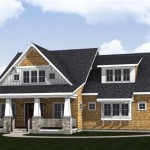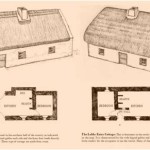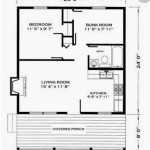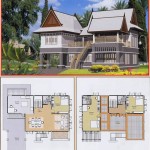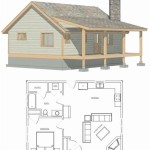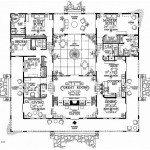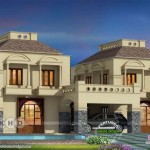House Plans With Kitchen In The Back: Design Considerations and Benefits
The arrangement of a house's interior spaces significantly impacts its functionality, flow, and aesthetic appeal. One popular design approach places the kitchen at the back of the house. This configuration offers various advantages and disadvantages, contingent on homeowner preferences, lifestyle, and specific site conditions. Understanding the nuances of house plans with the kitchen in the back is essential for making informed decisions during the design or renovation process.
This article provides an overview of the key considerations involved in designing houses with kitchens located at the back. It explores the benefits, potential drawbacks, and design strategies for successfully implementing this layout. It is crucial to consider the specific needs of a family and lifestyle when selecting a house plan as any floor plan will come with both benefits and compromises.
Optimizing Natural Light and Views
Placing the kitchen at the back of the house often affords the opportunity to maximize natural light and views. This is particularly true if the back of the house faces a garden, yard, or scenic landscape. Large windows, sliding glass doors, and skylights can be integrated into the kitchen design to flood the space with daylight and provide visual access to the outdoors. This can improve the overall ambiance of the kitchen and create a more pleasant cooking and dining experience.
Furthermore, locating the kitchen at the back can facilitate the creation of an indoor-outdoor living space. Sliding glass doors can seamlessly connect the kitchen to a patio, deck, or backyard, extending the living area and providing a convenient space for outdoor dining and entertainment. This connection is particularly advantageous in climates with mild weather, allowing for year-round enjoyment of the outdoor space. The access also benefits from ease of access to a garden for fresh herbs and vegetables.
When maximizing natural light, it is important to consider the orientation of the house and the potential for glare and heat gain. East-facing kitchens may receive intense morning sun, while west-facing kitchens may be subject to harsh afternoon sunlight. Window treatments, such as blinds, shades, or curtains, can be used to control the amount of light entering the space and prevent overheating. Alternatively, strategically placed landscaping can provide shade and reduce glare.
Moreover, the placement of windows should be carefully considered to ensure privacy, especially if the back of the house faces neighboring properties. High windows, frosted glass, or strategic landscaping can help to maintain privacy without sacrificing natural light. The location of the windows also needs to accommodate cabinetry and appliances to optimize the functionality of the kitchen layout.
Incorporating views into the kitchen design requires careful planning and consideration of the surrounding landscape. If the view is particularly appealing, the kitchen layout should be oriented to maximize visual access. Sinks and cooking areas can be positioned to face the windows, allowing the user to enjoy the view while performing daily tasks. The height of the windows should also be adjusted to provide an optimal viewing angle. It is also worth considering how the neighbors view the home, as the kitchen is likely to become a gathering spot.
Enhancing Social Interaction and Functionality
A kitchen located at the back of the house can promote social interaction and enhance the overall functionality of the living space. This layout often allows for a more open and connected floor plan, integrating the kitchen with the living room and dining area. This open concept design fosters a sense of togetherness and allows family members and guests to interact seamlessly while preparing meals, relaxing, or entertaining.
An open concept kitchen can also improve the flow of traffic within the house. Placing the kitchen at the back allows for a direct connection to the living and dining areas, eliminating the need to navigate through hallways or other enclosed spaces. This can be particularly beneficial for families with young children, as it allows parents to supervise their children while cooking or participating in other household activities.
The kitchen's location at the back can also facilitate the creation of a central gathering space. A large kitchen island can serve as a focal point, providing ample counter space for food preparation, serving, and casual dining. The island can also function as a social hub, encouraging conversation and interaction among family members and guests. The island is often the center of the home and needs to be carefully considered.
Furthermore, a kitchen located at the back can be easily connected to outdoor living spaces, such as patios, decks, and backyards. This allows for seamless indoor-outdoor entertaining, facilitating the movement of food and drinks between the kitchen and the outdoor area. This connection can be particularly advantageous during warmer months, allowing for al fresco dining and outdoor gatherings. Consider the space between the kitchen and the cooking area when designing the kitchen.
When designing an open concept kitchen, it is important to consider the potential for noise and odors to travel throughout the living space. A powerful range hood can help to remove cooking odors and prevent them from spreading to other areas of the house. Soundproofing materials can also be used to minimize noise transmission between the kitchen and the living room. The appliances also make a big difference and should be considered during the selection phase.
Moreover, the placement of appliances and work zones should be carefully considered to optimize the functionality of the kitchen. The work triangle, which connects the sink, refrigerator, and cooking area, should be designed to minimize steps and promote efficient workflow. Ample counter space should be provided for food preparation, and storage solutions should be incorporated to keep the kitchen organized and clutter-free. The selection of appropriate materials will enhance the overall durability and longevity of the kitchen.
Addressing Practical Considerations and Potential Challenges
While locating the kitchen at the back of the house offers numerous benefits, it is important to address potential practical considerations and challenges. One common concern is the potential for increased foot traffic through the kitchen, particularly if it serves as a primary access point to the backyard or other outdoor areas. This can disrupt the flow of traffic and make it difficult to maintain a clean and organized kitchen.
To mitigate this issue, it is important to consider alternative access points to the backyard, such as a side door or a separate entrance through the living room. The kitchen layout can also be designed to minimize the impact of foot traffic, with work zones and appliances located away from primary pathways. It is important to consider the overall layout of the house and how the kitchen fits into the overall flow of traffic.
Another potential challenge is the need to run plumbing and electrical lines to the back of the house. This can add to the construction costs and may require significant modifications to the existing structure. It is important to consult with qualified contractors and engineers to assess the feasibility and cost-effectiveness of running utilities to the desired location. The location of existing plumbing and electrical infrastructure should also be considered.
Furthermore, the placement of the kitchen at the back of the house may impact the natural light and ventilation in other areas of the house. If the kitchen blocks access to natural light, it may be necessary to incorporate additional windows or skylights in other rooms. Similarly, if the kitchen obstructs airflow, it may be necessary to install additional ventilation systems to ensure proper air circulation throughout the house. The orientation of the house and the placement of windows and doors should be carefully considered to maximize natural light and ventilation.
Additionally, the design of the kitchen should complement the overall architectural style of the house. A modern kitchen may look out of place in a traditional-style home, and vice versa. It is important to consider the existing architectural features and design elements when selecting materials, finishes, and appliances for the kitchen. The kitchen should be designed to seamlessly integrate with the rest of the house and create a cohesive and harmonious living space. If a more modern look is preferred, consider ways to blend the new with the classic style of the home.
Finally, it is important to consider the resale value of the house when designing the kitchen. A well-designed and functional kitchen can significantly increase the value of the home, while a poorly designed kitchen can detract from its appeal. It is important to consult with real estate professionals to understand the local market trends and preferences and to ensure that the kitchen design meets the needs of potential buyers. The return on investment for kitchen remodels can vary widely depending on location, market conditions, and the quality of the renovation.

Floor Plan Friday Kitchen Scullery And Laundry At The Rear Home Design Plans Dream House

Contemporary Home Plans With Great Kitchens Houseplans Blog Com

Plan 56476sm One Story New American Farmhouse With Outdoor Kitchen On Back Porch Plans Garage House

Entrance Centered On Dining All Living The Back Mom S Office In Front Of Kitchen Study Den Allisonramsey Floor Plans Southern House

Floor Plan Friday Scullery And Laundry On The Back Home Design Plans Dream House New

Floor Plan Friday Kitchen Scullery And Laundry At The Rear Home Design Plans Dream House

Type 3 Back To Floor Plans And Cross Section The Top Plan In Each Scientific Diagram

House Plan 6 Bedrooms 3 5 Bathrooms Garage 3897 Drummond Plans

French Country House Plan With 2 Kitchens 70502mk Architectural Designs Plans

1 Story 2 Bedroom Bathroom Kitchen Dining Room Family Car Garage 1806 Sq Fee House Plans One

